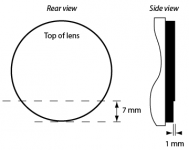telenous
Well-known
Despite the fact I am already having another 35mm lens I find myself inexorably interested in the Summilux 35 preasph, primarily (but not solely) for reasons of compactness. I am aware of the 'performance issues' as documented time and again here and there, in fact I have myself some experience with a very early Summilux 35 preasph with goggles that I used for about 4 months with an M3 I had about a year and half ago. Let me also say that I am aware of the various available alternatives in that or related focal lengths but at this stage I am interested in this lens only.
My question regarding this lens has to do specifically with another rumour circulating in the web, to the effect that the lens was actually recomputed from a point onwards (googling it, I find consistent references to a man called Hasbroeck indicating S/N 2166702 as the exact point of change; Laney seems to differ). Since Leica itself never confirmed a change in the optical configuration of the lens, or even of the coating applied to the lenses, I was wondering whether people here with experience of more than one sample could confirm a difference in performance between earlier and later Summilux 35 preasph lenses in their production run. In particular, do later lenses eliminate some of the flare presumably, in fact certainly, present in the earlier ones when used wide open? If yes, is there some indication (perhaps differing from the Hasbroeck's claim) as to the S/N that these changes came into effect? I 'd greatly appreciate any photos illustrating these differences (and I am sure they will make the thread more interesting to read).
I am addressing this question in Tom A's subforum, not just because of his extensive (well, huge) experience with all the M-mount lenses and the respect he commands in our community, but also because in a quick google search he's the only one I know to have declared some knowledge from the Elcan-Midland factory on the matter (in an archived RFF thread). However, if the mods feel this question belongs more to the Leica M forum, please do move the thread accordingly.
Thanks for any input in advance!
My question regarding this lens has to do specifically with another rumour circulating in the web, to the effect that the lens was actually recomputed from a point onwards (googling it, I find consistent references to a man called Hasbroeck indicating S/N 2166702 as the exact point of change; Laney seems to differ). Since Leica itself never confirmed a change in the optical configuration of the lens, or even of the coating applied to the lenses, I was wondering whether people here with experience of more than one sample could confirm a difference in performance between earlier and later Summilux 35 preasph lenses in their production run. In particular, do later lenses eliminate some of the flare presumably, in fact certainly, present in the earlier ones when used wide open? If yes, is there some indication (perhaps differing from the Hasbroeck's claim) as to the S/N that these changes came into effect? I 'd greatly appreciate any photos illustrating these differences (and I am sure they will make the thread more interesting to read).
I am addressing this question in Tom A's subforum, not just because of his extensive (well, huge) experience with all the M-mount lenses and the respect he commands in our community, but also because in a quick google search he's the only one I know to have declared some knowledge from the Elcan-Midland factory on the matter (in an archived RFF thread). However, if the mods feel this question belongs more to the Leica M forum, please do move the thread accordingly.
Thanks for any input in advance!
Last edited:








